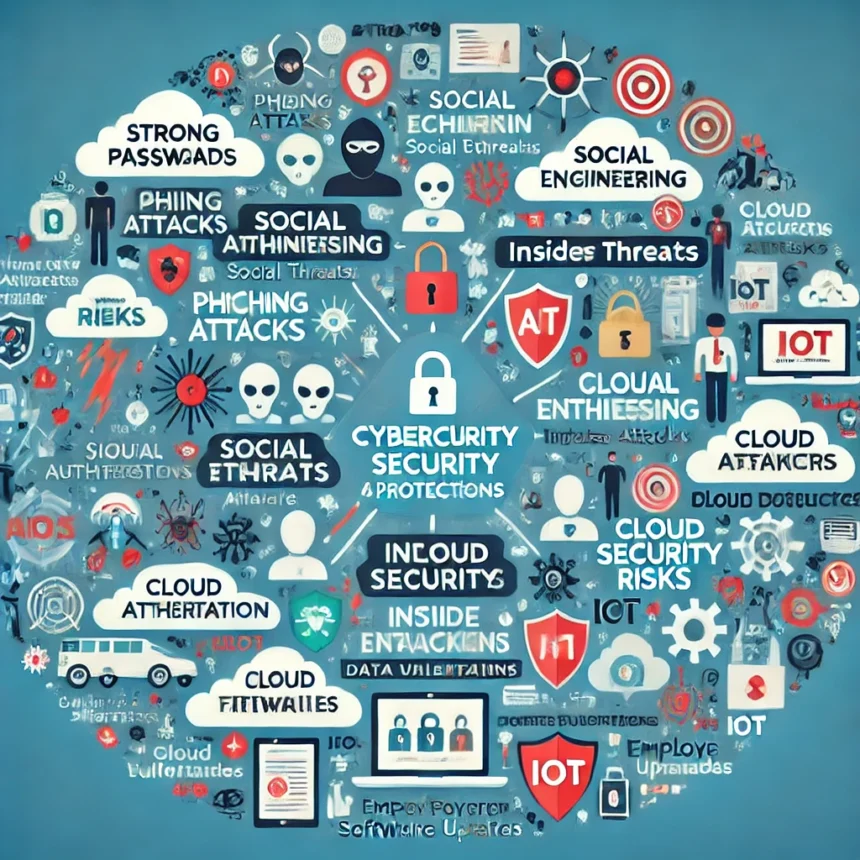In today’s digital environment, individuals and businesses face an increasing number of sophisticated cybersecurity threats. These threats range from traditional malware to emerging attacks exploiting new technology trends. To effectively protect sensitive data and ensure digital security, it’s crucial to understand the diverse nature of these threats and how to mitigate them.
1. Common Cybersecurity Threats
Phishing Attacks
Phishing is a type of social engineering attack where cybercriminals trick individuals into disclosing sensitive information by posing as legitimate institutions. Phishing attacks can occur through email, SMS, or social media. One common tactic is sending emails that appear to be from trusted companies like banks or government agencies. Once the victim clicks on a link or downloads an attachment, they are directed to a fake website or malware is installed on their device.
- Example: In 2020, the Twitter accounts of high-profile individuals were compromised in a phishing scam, causing widespread disruption. Attackers accessed their accounts by tricking employees with access to Twitter’s internal tools.
- How to Protect Yourself: Always verify the sender’s email address, avoid clicking on suspicious links, and use anti-phishing software that can detect and block these threats.
Malware
Malware refers to malicious software designed to infiltrate systems, steal information, or cause disruption. Some common types of malware include viruses, trojans, ransomware, and spyware. Ransomware has become particularly dangerous, as it locks users out of their systems and demands payment (usually in cryptocurrency) for restoring access.
- Example: The WannaCry ransomware attack in 2017 infected hundreds of thousands of computers worldwide, exploiting vulnerabilities in Microsoft Windows. It disrupted hospitals, telecommunications, and government services.
- How to Protect Yourself: Keep your operating system and software up-to-date, install antivirus software, and avoid downloading attachments from untrusted sources.
Social Engineering
Social engineering involves psychological manipulation to trick users into revealing confidential information or performing certain actions, such as transferring money. Attackers often impersonate colleagues, authority figures, or IT staff.
- Example: In 2013, cybercriminals used social engineering to gain access to Target’s corporate network. They tricked a third-party vendor into revealing their credentials, which led to the theft of over 40 million credit card records.
- How to Protect Yourself: Always verify the identity of the person requesting sensitive information, and encourage cybersecurity awareness training for all employees.
Distributed Denial of Service (DDoS) Attacks
In a DDoS attack, cybercriminals flood a website or server with excessive traffic, overwhelming its capacity and causing it to crash. These attacks aim to disrupt services, often for extortion purposes or as part of a broader cyber campaign.
- Example: In 2016, the Dyn DNS provider was hit by a massive DDoS attack involving the Mirai botnet. This attack affected major websites like Twitter, Reddit, and Netflix by overwhelming the DNS provider.
- How to Protect Yourself: Use DDoS protection services, such as traffic filtering or rate-limiting, and have backup servers in place.
Insider Threats
Insider threats come from within the organization and can include employees, contractors, or business partners who have access to sensitive information. These insiders may intentionally or unintentionally leak confidential data.
- Example: In 2021, a Tesla employee was reportedly offered $1 million by an outsider to plant malware inside Tesla’s network, highlighting the risk of insider threats. Tesla caught and reported the employee before the attack could occur.
- How to Protect Yourself: Implement strict access controls, regularly audit employee activity, and ensure proper vetting during the hiring process.
2. How to Protect Your Data
Use Strong, Unique Passwords
Password protection remains a fundamental aspect of cybersecurity. However, using weak passwords makes it easy for hackers to crack them using techniques like brute force or dictionary attacks.
- Recommendation: Use long passwords with a combination of letters, numbers, and symbols. Avoid common phrases, and never reuse passwords across multiple sites. Consider using a password manager to store and generate complex passwords securely.
Enable Multi-Factor Authentication (MFA)
MFA requires users to verify their identity through multiple factors, such as something they know (password), something they have (a mobile device), or something they are (fingerprint or facial recognition). This adds a crucial layer of protection.
- Example: Google has reduced account hijacking by over 99% for users who enabled MFA on their accounts.
- Recommendation: Enable MFA on all critical accounts, including emails, financial services, and cloud services.
Keep Software Updated
Outdated software often contains vulnerabilities that hackers exploit. Software updates usually contain security patches that address these vulnerabilities.
- Recommendation: Enable automatic updates for all operating systems, browsers, and antivirus software to ensure they are always up-to-date with the latest security measures.
Implement Data Encryption
Encryption converts sensitive data into a secure code that can only be accessed by authorized users with the decryption key. This ensures that even if data is intercepted, it cannot be read by unauthorized parties.
- Recommendation: Encrypt all sensitive data, both at rest (when stored) and in transit (during transmission). Use secure communication protocols such as HTTPS and VPNs when accessing sensitive data over the internet.
Backup Your Data
Regular backups ensure that you have copies of your data in case it’s lost or stolen. Ransomware attacks are particularly devastating if there are no backup copies of the compromised data.
- Recommendation: Perform frequent backups to an external or cloud storage that is not connected to your network. Ensure that these backups are encrypted and secured.
Use Firewalls and Antivirus Software
A firewall acts as a barrier between your system and potential attackers, filtering incoming and outgoing traffic based on predefined rules. Antivirus software detects and removes malicious software.
- Recommendation: Install firewalls on all devices and networks. Use reputable antivirus programs to scan and remove malware regularly. Keep both systems updated to defend against new threats.
Educate Employees and Conduct Regular Training
Human error is one of the most common causes of data breaches. Educating yourself and your employees about cybersecurity best practices is key to preventing phishing attacks, social engineering, and other human-targeted threats.
- Recommendation: Conduct regular cybersecurity training sessions, update employees on the latest cyber threats, and create awareness about how to avoid phishing scams and other attacks.
3. Emerging Cybersecurity Threats
Cloud Security Risks
As more businesses move to cloud-based environments, there is an increased risk of security breaches due to misconfigurations, inadequate access controls, and the shared responsibility model between cloud providers and users.
- Recommendation: Ensure that proper access controls and encryption are in place. Regularly audit your cloud environments for vulnerabilities.
Artificial Intelligence (AI)-Powered Attacks
AI is a double-edged sword in cybersecurity. While it can help detect attacks, cybercriminals also use AI to craft more sophisticated phishing attacks or automate hacking attempts.
- Recommendation: Use AI-powered defense tools that can analyze network traffic and detect anomalies in real-time. Train your team to recognize AI-driven phishing and social engineering attacks.
IoT Vulnerabilities
The rise of IoT devices presents new security challenges, as many of these devices are not designed with security in mind. Hackers can exploit unsecured IoT devices to access networks or launch DDoS attacks.
- Recommendation: Secure IoT devices by changing default passwords, using strong encryption, and keeping the devices updated with the latest firmware patches.
Conclusion
Cybersecurity is a dynamic field with constantly evolving threats. While there is no single solution to staying safe, following best practices like using strong passwords, enabling MFA, keeping software up to date, and conducting regular training can significantly reduce the risk of a breach. By being proactive and prepared, individuals and businesses can protect their valuable data from cyberattacks.




